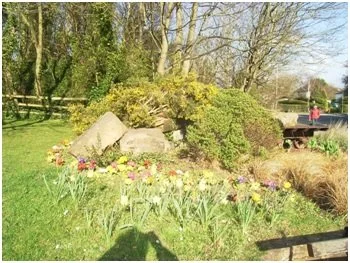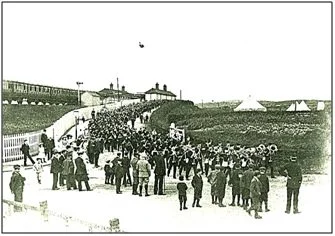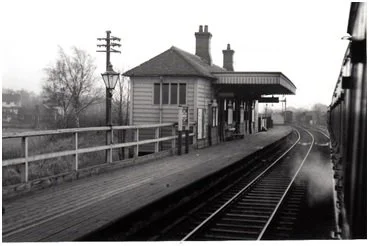PARKGATE Station
Parkgate’s Second Station
This small park reminds us of some of the activities which were once carried on close to this now relatively peaceful little area.
Ropewalk Garden, Spring 2019 Photo: Alan Passmore
In the wooded area just behind here once stood the second Parkgate Station, completed in 1886, when the railway line from Hooton was extended from here to West Kirby. The nearby cottage in the Ropewalk was once a shop, which in the early part of the last century was frequented by travellers using the railway. A cobbled path starting between the electricity sub-station and this cottage still leads up to the former north-bound platform of the railway station, which trains arriving from the Neston direction reached after crossing Station Road by a steel plate girder bridge, shown in one of the following photos, but now long since demolished. The following map shows some of these features.
1912 map, showing Parkgate Station layout
In the early years of the 20th century this station was used in the summer by part-time British soldiers (volunteers), who came to Parkgate to practise artillery shooting over the Dee estuary. Various different battalions would come to spend a week or fortnight camping in the nearby Park Fields and march off each day with their equipment to their artillery range on what later became the North Parade to fire off a few rounds of shells. This activity drew considerable attention from local inhabitants, as seen in the next picture; they would turn out to watch these exercises and try to retrieve the spent shell casings to use as souvenirs.
This photo shows locals watching the arrival of the 1st Worcestershire RGA (Volunteers), led by their band, for their annual summer camp in Park Fields; their tents have already been erected for them. This view shows the station of 1886 together with its approach road; the location is the junction of Station Road with Parkgate Road.
Photo: Arthur Maycock, David Scott collection
Taken from almost the same spot this photo shows Station Road railway bridge and a section of the parade commemorating the coronation of George V on 22 June 1911.
Photo: Arthur Maycock, David Scott collection
Parkgate Station c 1950
Looking towards Neston from a West Kirby-bound train; in the distance, beyond the signal, another train can be seen departing for Hooton.
The Ropewalk
This spot is situated at the southern end of the Ropewalk, a straight path of about six hundred yards (c 0.55 km), which leads from here to what is now Brooklands Road. During the period between 1814 and the 1970s it was named Cheltenham Walk. From the Georgian era the town of Cheltenham was a very fashionable watering place, and during Parkgate’s heyday as a well-known and aspiring resort, this already existing path became a place where its fashionable visitors could stroll or promenade, particularly if the weather conditions on The Parade were not sufficiently conducive for this activity to be carried on there. The nearby terrace of Edwardian houses in Station Road is known as Cheltenham Place, reinforcing Parkgate’s claim to fashionable status.
The origin of this path goes back much further, however, to the days when there was a ship-building industry in Parkgate and consequently a need for ship rope for rigging and other related nautical purposes. It would have been here that long strands of hemp were laid out before being twisted together to make the substantial lengths of rope that were used in fitting out the sailing vessels which were constructed or repaired in the Parkgate shipyards during the 17th and 18th centuries. It is said that sailing ships of the size of HMS Victory required over 20 miles (32 km) of rope.
The Neston Colliery Branch
It was from about here that a mineral branch line (standard gauge) diverged southwards beyond Moorside Lane bridge to serve the Neston (later Wirral) colliery at the bottom of Marshlands Road, in Little Neston. The loaded coal trains from the colliery had to reverse here, at Parkgate, before being hauled up the steep gradient through Neston to meet the main line at Hooton.
A relaxed moment at Neston colliery
Many collieries (though not Neston) had their own internal narrow gauge railway systems, usually for moving coal underground from the coal face; ponies would often be used to haul the wagons. Similar systems operated above ground in opencast mines, quarries and at other industrial sites. The little truck placed here has no direct connection with Neston colliery, but it is symbolic of the wagons that were commonly used in the many mining and quarrying systems that once existed all over this country, before the quarried material was handed over to the ‘big’ railway.
The quarry truck displayed in the Ropewalk Garden
Photo: Alan Passmore (2019)
The Last Years of the Railway
The closure of the colliery in 1927, with the loss of over 200 jobs, was a great blow to the area at a time when the country was entering a period of general depression; in particular it had a serious effect on the viability of the railway. However, the railway managed to struggle on until 1956, still offering a reasonable passenger service, but at an ever-increasing loss; the goods service continued until 1962. For a few months subsequently the line was used for the training of staff in the operation of the new diesel railcars that were being introduced elsewhere. Following the removal of the track and other infrastructure, including the bridge over Station Road, the site soon returned to nature. The station site, like most of the former trackbed of the West Kirby branch, was subsequently acquired by Cheshire County Council and redeveloped as the Wirral Country Park, formally opened in 1973. Generally referred to as the Wirral Way this asset is currently managed respectively by the park rangers of Wirral MBC and Cheshire West (CWaC).
The Wirral Way
This is the site of the former Parkgate station in 2019.
Photo: Alan Passmore
Except where otherwise attributed,
illustrations are from the David Scott card collection by kind permission of the Burton & Neston History Society.
Last Updated January 2023







